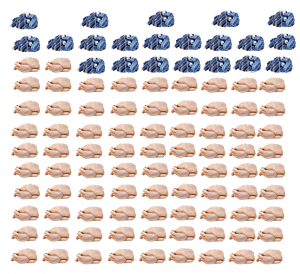 The 2016 Dogs Trust survey of local authority dog wardens and environmental health officers in England, Scotland, Wales and Northern Ireland has just been published. 370 local authorities with responsibility for environmental health in Great Britain. returned 338 questionnaires by the deadline and 3 after, giving a response rate of 92%.
The 2016 Dogs Trust survey of local authority dog wardens and environmental health officers in England, Scotland, Wales and Northern Ireland has just been published. 370 local authorities with responsibility for environmental health in Great Britain. returned 338 questionnaires by the deadline and 3 after, giving a response rate of 92%.
Local authorities were responsible for seizing 78% of strays. 17% were handed in by the general public, figures that have remained stable over recent years. the remaining 5% were handed in by the police (1%), under the Dangerous Dogs Act (1%), picked up by other means (3%) or already in local authority kennels on 1st April 2015 (1%). Transfers from vets, the RSPCA, dog wardens, and other agencies each accounted for fewer than 1% of reported strays.
This represents 81,050 stray dogs handled by local authorities in the last year. Although this is a decrease of 21% on the previous year when 102,516 dogs were handled by local authorities, there is no cause for celebration.
Just 29% (16,447) dogs were microchipped. 64% of these dogs face being destroyed by local authorities because their owners have not updated their contact details which, as of April 2016, has been illegal. Just 478 microchipping enforcement notices had been served between April 6th 2016 and the survey deadline of July 31st, 2016. 51% were due to the stray dogs being unchipped and 49% were due to the chip having incorrect details stored. 43,767 of the 81,050 stray dogs were reunited with their owners, with more than 9,000 reunifications due to a correctly registered microchip. ID disks accounted for 1,161 reunions and a combination of the two for 768 reunions. 7,341 dogs were reunited due to the owner contacting the local authority or pound directly. 662 dogs were reunited due to already being known to the dog warden. The numbers of stray dogs chipped with a foreign microchip has remained globally stable, although numbers vary across authorities. 18% did not require kennelling.
170 of the 292 local authorities offered a microchipping service, with 41% of those making it free of charge to the owner using Dogs Trust chips, 6% offering it free at a cost to the council and 20% requiring the owner to pay. Many authorities used a mixture, such as allowing free chipping in some cases but requiring the owner to pay in others.
3,463 stray dogs were destroyed by local authorities leaving 37,283 dogs unclaimed in council kennels. The reported number of stray dogs that were re-homed by local authorities across the UK fell from 8,465 in 2015 to 6,143 this year. However, this accounts for the same proportion that were re-homed by local authorities as last year (9%) due to the decrease in the estimated total number of strays. Just under a quarter (22%) of the strays handled were passed on to welfare organisations or dog kennels after the statutory period of kennelling. This proportion remains the same as last year and is in line with estimates over the last 10 years. A small proportion of dogs were kept or retained by finders, were dead when found or died in kennels.
216 (70%) of local authorities employ a dog warden directly whereas 76 authorities (25%) contract the service out.
206 (72%) authorities house strays in private boarding kennels, 28 (9%) use a council-owned pound and 82 (27%) use charity kennels. The remaining 20 authorities said that they used an alternative option for handling their strays. 293 (95%) of authorities run dog warden services during working hours Monday to Friday and 101 during working hours on Saturdays and Sundays. 141 (46%) work on-call out of working hours Monday to Friday and 147 authorities operated an on-call service out of hours on weekends, with 50% of all LAs reporting offering an out-of-hours service at any time. This is broadly consistent with finding from previous years.
14,519 (19%) of all strays reported as being handled by local authorities were regarded as being so-called “status dogs” and tended to be bull breeds, Rottweilers, Akitas or crosses of these breeds, representing a reduction of 21% on 2015. of those, 738 (5%) were euthanised due to aggressive behaviour. This proportion has been declining gradually from a reported 8% in 2013-14 to 6% in 2014-15.
These figures are simply disgraceful. Any improvements do not disguise the fact that far too many dogs are straying or being dumped. So much for the “nation of dog lovers”.

